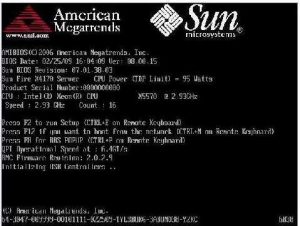The BIOS beep codes that provide information on errors

The make of UEFI or BIOS is usually provided on the startup flash screen, as shown above. Click on the image to view its full size. That screen can be paused by pressing the Pause key. The computer from which the image was taken uses an AMI BIOS. Its date and version are provided.
If you cannot obtain the BIOS make and version from the startup screen, a free tool, such as the Belarc Advisor, provides that information, along with all of the other information on the hardware and software installed on a computer.
The standard and UEFI BIOS can provide error-alert messages to the user of the computer by using sounds (usually one or more long or short beeps provided by the speaker built into the computer’s case), text messages, or now even by issuing voice messages. Each make of BIOS has its own set of beep codes that are usually provided in the motherboard’s user manual for a desktop PC that is usually available as a download in the PDF format from the website of its manufacturer – Asus, MSI, Gigabyte, Asrock, etc.
Obviously if the computer’s video card doesn’t work for some reason, a text error message is of no use, so most BIOSes issue a beep code to alert the user to an error in configuring the video card.
Should you need it, entering the search phrase bios beep codes in a web-search engine should produce many links to sites with beep-code information. If you know the make of the BIOS – e.g. – IBM, Award, AMI, etc – use the make in front of the search query, such as: award bios beep codes.
Note that the PC must have a speaker built into the case, which laptops always have but which not many PC have now, in order to be able to hear the beeps. Read the PC’s user manual to find out how the BIOS reports error messages. Some motherboards use codes displayed on an LED display on the motherboard or on a display at the back of the case that you have to look up. The information is usually provided in the motherboard’s user manual and/or online. Most motherboard manufacturers provide user manuals for their boards in the PDF format online.
Here is a link to a webpage that provides the beep codes for the most popular makes of BIOS:
Power On Self Test – POST Beep Codes –
http://www.pchell.com/hardware/beepcodes.shtml
Page 4 – Shutting Windows 8.1/10 down completely in order to enter the BIOS